-
 Surgical Incision Retractor
Surgical Incision Retractor Retractors, like this antique example, are tools used to pull away soft tissue and organs from parts of the body that must be accessed to perform vital surgical procedures on patients. There is archaeological evidence of this tool being used as far back as the Stone Age.
-
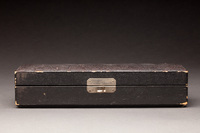 De Zeng Ophthalmoscope
De Zeng Ophthalmoscope This tool was created in the early 20th Century by De Zeng as a tool to help examine the back of the fundus, or back of the eye. This tool is used to help analyze the health of the retina.
-
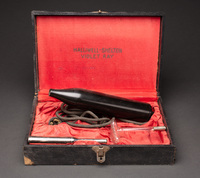 Halliwell-Shelton Violet Ray
Halliwell-Shelton Violet Ray The Halliwell-Shelton Violet Ray was made in 1930's to use high voltage with low current for a variety of problems from nervous conditions to brain fog. They are however outdated and can be dangerous to use for more than ten minutes.
-
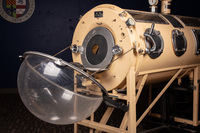 The Iron Lung
The Iron Lung The iron lung was a device popularly used in the U.S. from the 1930s until an effective vaccination was developed for polio in the 1950s. It was an innovative medical tool that saved many lives.
-
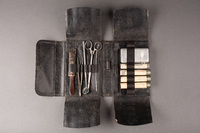 Tool Kit
Tool Kit
-
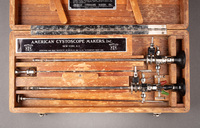 Brown Buerger Cystoscope
Brown Buerger Cystoscope The Cystoscope was introduced in 1907 as a way to diagnose as well as monitor issues regarding the bladder and urethra, such as problems in the urinary tract.
-
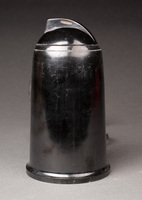 DeVilbiss Electric Steam Vaporizer
DeVilbiss Electric Steam Vaporizer The DeVilbiss Electric Steam Vaporizer was made by the company DeVilbiss, founded in 1888. The machine was used to help vaporize medication so you could inhale medication to treat things such as colds, sore throats, or other respiratory illnesses.
-
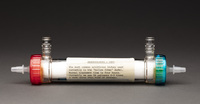 Hemodialysis
Hemodialysis Hemodialysis treatments are used to help the body filter waste and water from your blood and maintain blood pressure in place of the kidney.
-
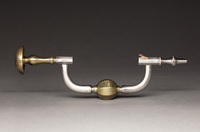 Trepan Frame
Trepan Frame A tool produced sometime in the late 18th/early 19th Century. By this time, trepans had begun to fall out of popular usage, their last spike in popularity being in South America from the 14th-16th Centuries. It works by moving in circular portions against the skull to drill a hole for access in early neurocranial procedures.
 Surgical Incision Retractor Retractors, like this antique example, are tools used to pull away soft tissue and organs from parts of the body that must be accessed to perform vital surgical procedures on patients. There is archaeological evidence of this tool being used as far back as the Stone Age.
Surgical Incision Retractor Retractors, like this antique example, are tools used to pull away soft tissue and organs from parts of the body that must be accessed to perform vital surgical procedures on patients. There is archaeological evidence of this tool being used as far back as the Stone Age. De Zeng Ophthalmoscope This tool was created in the early 20th Century by De Zeng as a tool to help examine the back of the fundus, or back of the eye. This tool is used to help analyze the health of the retina.
De Zeng Ophthalmoscope This tool was created in the early 20th Century by De Zeng as a tool to help examine the back of the fundus, or back of the eye. This tool is used to help analyze the health of the retina. Halliwell-Shelton Violet Ray The Halliwell-Shelton Violet Ray was made in 1930's to use high voltage with low current for a variety of problems from nervous conditions to brain fog. They are however outdated and can be dangerous to use for more than ten minutes.
Halliwell-Shelton Violet Ray The Halliwell-Shelton Violet Ray was made in 1930's to use high voltage with low current for a variety of problems from nervous conditions to brain fog. They are however outdated and can be dangerous to use for more than ten minutes. The Iron Lung The iron lung was a device popularly used in the U.S. from the 1930s until an effective vaccination was developed for polio in the 1950s. It was an innovative medical tool that saved many lives.
The Iron Lung The iron lung was a device popularly used in the U.S. from the 1930s until an effective vaccination was developed for polio in the 1950s. It was an innovative medical tool that saved many lives. Tool Kit
Tool Kit
 Brown Buerger Cystoscope The Cystoscope was introduced in 1907 as a way to diagnose as well as monitor issues regarding the bladder and urethra, such as problems in the urinary tract.
Brown Buerger Cystoscope The Cystoscope was introduced in 1907 as a way to diagnose as well as monitor issues regarding the bladder and urethra, such as problems in the urinary tract. DeVilbiss Electric Steam Vaporizer The DeVilbiss Electric Steam Vaporizer was made by the company DeVilbiss, founded in 1888. The machine was used to help vaporize medication so you could inhale medication to treat things such as colds, sore throats, or other respiratory illnesses.
DeVilbiss Electric Steam Vaporizer The DeVilbiss Electric Steam Vaporizer was made by the company DeVilbiss, founded in 1888. The machine was used to help vaporize medication so you could inhale medication to treat things such as colds, sore throats, or other respiratory illnesses. Hemodialysis Hemodialysis treatments are used to help the body filter waste and water from your blood and maintain blood pressure in place of the kidney.
Hemodialysis Hemodialysis treatments are used to help the body filter waste and water from your blood and maintain blood pressure in place of the kidney. Trepan Frame A tool produced sometime in the late 18th/early 19th Century. By this time, trepans had begun to fall out of popular usage, their last spike in popularity being in South America from the 14th-16th Centuries. It works by moving in circular portions against the skull to drill a hole for access in early neurocranial procedures.
Trepan Frame A tool produced sometime in the late 18th/early 19th Century. By this time, trepans had begun to fall out of popular usage, their last spike in popularity being in South America from the 14th-16th Centuries. It works by moving in circular portions against the skull to drill a hole for access in early neurocranial procedures.